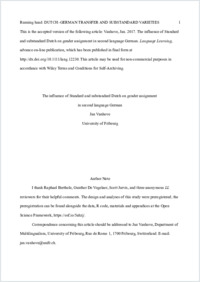The influence of Standard and substandard Dutch on gender assignment in second language German
BLE-BLL
- Vanhove, Jan University of Fribourg
-
2017
Published in:
- Language Learning. - 2017, p. 1-47
English
This study investigated how standard and substandard varieties of first language (L1) Dutch affect grammatical gender assignments to nouns in second language (L2) German. While German distinguishes between masculine, feminine, and neuter gender, the masculine–feminine distinction has nearly disappeared in Standard Dutch. Many substandard Belgian Dutch varieties, however, still mark this distinction, making them more akin to German than Standard Dutch in this respect. Seventy-one Belgian and 104 Netherlandic speakers of Dutch with varying levels of German proficiency assigned gender-marked German articles to German nouns with Dutch cognates; these gender assignments were then compared to the cognates’ gender in the standard and substandard L1 varieties. While the gender assignments of both Belgian and Dutch participants were strongly influenced by the cognates’ Standard Dutch gender, the Belgians’ responses showed, at best, weak traces of the masculine– feminine distinction in substandard Belgian Dutch. Possible reasons for this weak substandard variety influence are discussed.
- Faculty
- Faculté des lettres et des sciences humaines
- Department
- Département de plurilinguisme et didactique des langues étrangères
- Language
-
- English
- Classification
- Language, linguistics
- License
-
License undefined
- Identifiers
-
- RERO DOC 279090
- DOI 10.1111/lang.12230
- Persistent URL
- https://folia.unifr.ch/unifr/documents/305168
Statistics
Document views: 200
File downloads:
- Texte intégral: 304
